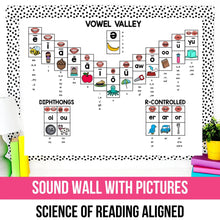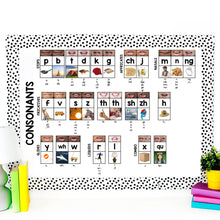Are you looking for a sound wall with mouth pictures? This science of reading-aligned sound wall is perfect for your classroom.
In this bundle I provided two sound wall options:
- sound wall with clip art
- sound wall with photos
- Individual Sound Wall with clipart
- Individual Sound Wall with photos
What is a Sound Wall?
A sound wall is a tool used to organize sounds (phonemes) and the letters (graphemes) used to make those sounds.
A sound wall looks very similar to a word wall, but the organization is quite different. Rather than focusing on letters, a sound wall focuses on sounds. The word dog, for example, has both three letters and three phonemes, or sounds: /d/o/g/. The word phone, on the other hand, has five letters, but only three phonemes (sounds): /ph/o/n/.
The realization that all letters make sounds can be a game changer for students. When we hear words, we hear phonemes put together (d/o/g/ = ‘dog’). While speaking is a natural process usually learned through immersion, reading and writing require more intentional instruction. The sound wall is an important component of this intentional instruction.
What is the purpose of a sound wall?
Reading and writing can be mysterious to the early learner. The twenty-six letters of the English alphabet make forty-four phonemes, or sounds, and there are over two hundred different ways to spell those sounds. Learning these phonemes helps enable early learners to ‘crack the code’.
The purpose of a sound wall is to help students to focus on sounds as they relate to letters and words. The sound wall can be used throughout the day by both the teacher and the students, making reading and writing easier.
How to Teach With the Sound Wall
Begin by introducing the sound, followed by the letter(s) that most commonly make that sound. For example, the sound /k/ is most commonly made by the letters c, k, or the ck combination.
Reference the wall regularly, including a daily review of each sound.
Demonstrate mouth movements to effectively make the sounds shown (included in the Orthographic Mapping Mega Bundle).
It’s important to practice these mouth movements with students. Small mirrors help children see what their lips and tongue are doing. This mouth work is optimally done in small groups to enable correction and coaching.
What’s next? Integrate the sound wall into writing activities throughout the day! Make certain that students know it’s their sound wall, and they should use it often!
Be sure to take a minute to admire your handiwork and the engagement and learning that are sure to follow. Your sound wall will be a game changer!
TERMS OF USE:
You can reproduce the pages for classroom use only. The fonts I used are free for personal use. Duplication of this resource for commercial purposes or for the entire school is strictly forbidden.
Customer Reviews
FAQ
Here’s everything you need to know about being a client.




















